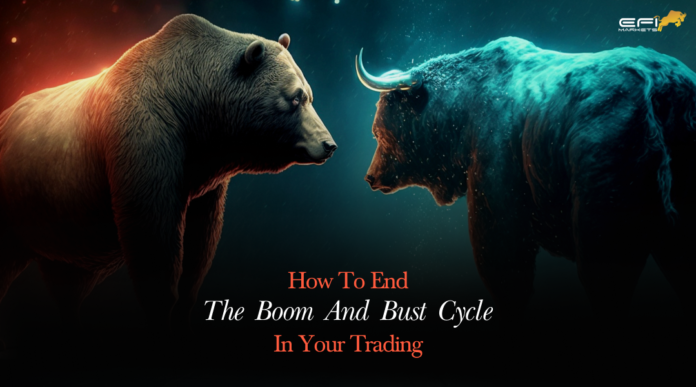The Boom-and-Bust cycle is the cyclical pattern of economic expansion and contraction. It’s another way of putting the economic or business cycle.
According to the Federal Reserve Bank of Richmond, these steps are undeniable. If you have a better understanding of their trading logic, process, and emotions. You can better defend yourself against their impacts
The Boom & Bust Cycle
The equity curve exhibits erratic fluctuations throughout this phase, with noticeable ups and downs. Days where the trader loses the previous profits and occasionally more come after days with several R wins. This is the hardest phase of all from a psychological standpoint. The feelings that traders feel range from joy to frustration, rage, and terror. When traders’ buttons are pressed, psychological problems including beliefs, training, instinctive responses, strengths, weaknesses, and many more come to the surface.
Practical tips to end the boom and bust cycle in your trading
The practical steps derived by Andrew Menaker, the high-performance coach are explained here. By exercising this, Traders can improve their results against the cyclical boom and bust cycle.
First, he classified the trader behavior in 4 steps
Type 1 trading is when you stick to your strategy and profit. All people enjoy these.
Type 2 trades occur when you stick to your strategy and are stopped out at the pre-set risk threshold. Although no one loves them, these are necessary for profitable trading.
Type 3 trades result in losses when you don’t follow your method.
Type 4 trading is when you veer from your strategy and still earn money. Two such instances are deals made out of rage or impulse.
First, he advised them to look for patterns in their trading. A Type 2 followed by one or more Type 3 or Type 4 deals is a highly typical pattern. Reduce Type 3 & 4 transactions as a target. Type 4 transactions are the riskiest because, despite the fact that they are profitable, they feed our ego and make us believe that we made the proper decision.
Process, outcome, and emotion handling in trading
Trading makes it difficult to separate the method from the result. It is human inclination to believe that any successful outcome, such as gaining money, was a good trade regardless of the calibre of the choice that produced it. It improves our mood. Human nature makes it a priority to avoid discomfort. The majority of trading’mistakes’ can be viewed as attempts to reduce discomfort.
In trading, it is quite simple to let the need to avoid discomfort—in all of its manifestations—take precedence, which keeps us mired in the P&L boom-and-bust cycle. A significant developmental problem in trading is the need to avoid suffering in all of its varied manifestations (waiting, missing out, incurring a loss, managing a winning deal, leaving money on the table, etc.).
Turning this around and putting long-term objectives before immediate demands for fulfilment, efforts to avoid suffering, and the conscious and unconscious fear of not (being) good enough need effort. Because many unmet needs and worries of not (being) good enough have extremely deep subconscious roots and frequently date back to infancy, it can be difficult to change one’s perspective.
Most boom and bust merchants have a deep-seated dread of not (being) enough, which keeps them on an endless hunt or embroiled in conflict. This struggle keeps repeating itself until both the conscious and subconscious components are adequately handled. The boom and cycle keep going.
Knowing that emotion is information, a signal to pay attention to, is helpful in addition to organizing your trades and separating process from outcomes. Very effective traders are aware that they are trading their own Inner Market (what they are feeling and why they are feeling that way) as much as the market they see on the screen, even if they can not express it in this way.
Conclusion
Hence Andrew in his analysis, he put forward a word called process, to trust it and traders have to gain insights to separate a good and bad trade. In the cyclical boom and bust cycle, the traders must face the struggle and should learn to handle various conscious and subconscious components. In addition, emotion can be used to streamline trade and separate the process from outcomes








